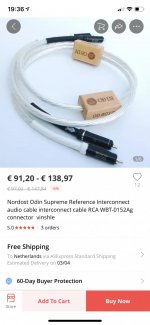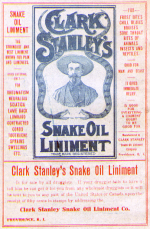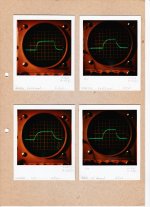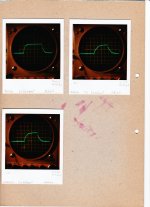We don't discover anything on a record that is not already there.
Well with Vinyl you get quite a lot off that wasn't there to start with!
You wonder why cable and wires can sound different? Well here is one other reason. Oxidation. And a test to prove it exists too.
No the scales are always important. Case in point take a length of cable with 0.01 Ohms resistance and pass an amp through it. One end is at 0 and the other at 10mV, please demonstrate how any internal points can be more that a few mV.
vertical axis: 0.5V per division, horizontal axis: 1V per division
Interesting diode volts per volts.
Interesting diode volts per volts.
It's a subjective sighted conclusion, EE101 is for wusses.
well, some people in high-end use a lot thicker than .5-1oz copper and then there are actual wires and cables, too.
Dont limit this to just a one case condition nor try to find the exception.
Copper oxide diode formation is a problem at any frequency.
Short of (again) some defense/space applications the thickest PCB copper I've seen is 4oz, and that was for some crazy power application. This is still 40% thinner than the skin depth @100KHz. This "skin effect in high end audio" topic appears periodically here and elsewhere; unlike other myths and legends I was able to trace back as far as around WW-II, this one remains of an unknown origin.
You don't seem to make a distinction between contact and conduction mechanisms. Copper oxide has virtually zero effect in conduction anywhere in the audio range; the typical copper oxide thickness in rectifiers is much thinner than a 0.5oz copper PCB. So there's no effect of copper oxide on the skin effect, anywhere under the hundreds of MHz and up. Copper corrosion, that's a different topic, which falls under the "pathological" category.
Many cables sound different in any case. EE101 is not enough.
No, some snake oil is absolutely required.
Just get to the bottom of this. Are you saying that skin effect is an audible factor in audio electronics? If so, where are the demonstrated cases?We are not talking VERY high freqs. The skin affect can be seen to come into play about 50-100KHz and above.
This is well within the amplifier BW and the DIODE effects due to oxidation can cause distortion... perhaps IM into audio depending on PA. However, we are talking about oxidation of copper surface and diode affects caused by the boundary between copper and oxide layer. This can occure at any freq but would be worse for HF.
Of course hard gold. That goes without stating. And, we do not consider cost when we are talking of audible sources and tests. Cost is a marketing issue. Many places can be masked... but then masks have their own undesired / measured affects. Not all masking material is the same.... some better than others for audio.
THx-RNMarsh
Any links?Many cables sound different in any case. EE101 is not enough.
It says "General Snake Oil". It has to be audio specific to be used for hi-end audio. Remember, it's only the best for that demography.

Getting a better marketing designer would take away the profit margin of these small audio businesses, a.k.a. garage operation. Why do you think some of them try to sneak in advertisement without paying on forums like this?If there’s nothing positive to tell apart from making claims how fantastic your cables are, this person is probably in the wrong business.
Maybe but not likely, a superior marketing concept could help him.
Hans
Where can I buy some? (snake oil)
No need to buy more, Jack Bybee already gave you a free lifetime stock.
Where can I buy some? (snake oil)
Attachments
Tip
Most of you probably know the Nordost Odin interconnect.
Price ca. $20,000.- per meter.
Here is a perfect alternative, built as an exact copy.
Hans
Faking a fake?
... Star-quad was/is an innovation over TP for some uses...
Many cables sound different in any case. EE101 is not enough.
If EE101 were enough, then all would have been said and done in audio, and we'd be slaughtering each other over fishing or knitting, or whatever.
OTOH, EE101 can sure get one started: attached are some cables I measured 40+ years ago using the method John Curl advocated at that time, and the differences are obvious. The first one, labeled Zung 2x2x1mm2 is a star quad configuration based on electric stove cables (3 phase + neutral): it's heads and shoulders above the others which are fashion cables of that time.
Attachments
Last edited:
I just took some time to have a look at the Bybee website.
This copy, including errors in the text, is what I found:
How it Works: The QSE affects the polarity of all electrons and protons within it’s magnetic field, affecting their oscillation by making them more aligned with each other. This reaction creates an affect the makes the transfer or sharing of electrons more streamline and efficient. The results are a stunningly enhanced purity and energy of the signal.
I can’t wait to spoil my electrons and protons with this creation.
Hans
This copy, including errors in the text, is what I found:
How it Works: The QSE affects the polarity of all electrons and protons within it’s magnetic field, affecting their oscillation by making them more aligned with each other. This reaction creates an affect the makes the transfer or sharing of electrons more streamline and efficient. The results are a stunningly enhanced purity and energy of the signal.
I can’t wait to spoil my electrons and protons with this creation.
Hans
I spoke to Jack Bybee this morning. He is still working on new discoveries. One is going into a power cord that his (and my) associate Mike, (who holds more degrees in both physics and engineering than most of you here) is producing.
Jack apparently doesn't want to make power cords, but focus his remaining years on fundamental devices that improve audio quality.
Jack apparently doesn't want to make power cords, but focus his remaining years on fundamental devices that improve audio quality.
- Status
- Not open for further replies.
- Home
- Member Areas
- The Lounge
- John Curl's Blowtorch preamplifier part IV



